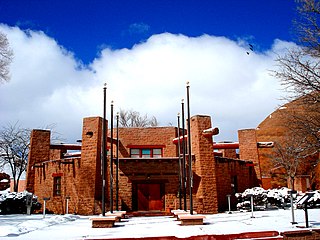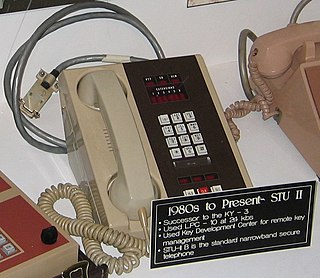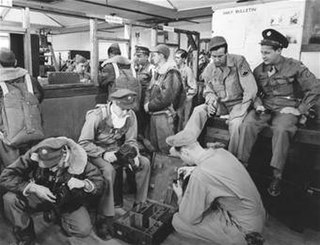
A code talker was a person employed by the military during wartime to utilize a little-known language as a means of secret communication. The term is now usually associated with United States service members during the world wars who used their knowledge of Native American languages as a basis to transmit coded messages. In particular, there were approximately 400 to 500 Native Americans in the United States Marine Corps whose primary job was to transmit secret tactical messages. Code talkers transmitted messages over military telephone or radio communications nets using formally or informally developed codes built upon their native languages. The code talkers improved the speed of encryption and decryption of communications in front line operations during World War II.

Window Rock is a small city that serves as the seat of government and capital of the Navajo Nation, the largest territory of a sovereign Native American nation in North America. It lies within the boundaries of the St. Michaels Chapter, adjacent to the Arizona and New Mexico state line. Window Rock hosts the Navajo Nation governmental campus which contains the Navajo Nation Council, Navajo Nation Supreme Court, the offices of the Navajo Nation President and Vice President, and many Navajo government buildings.

Leupp is a census-designated place (CDP) in Coconino County, Arizona, United States. The population was 951 at the 2010 census.

The Navajo Nation is a Native American territory covering about 17,544,500 acres, occupying portions of northeastern Arizona, southeastern Utah, and northwestern New Mexico in the United States. This is the largest land area retained by a Native American tribe, with a population of roughly 350,000 as of 2016.

Windtalkers is a 2002 American war film directed and produced by John Woo, starring Nicolas Cage, Adam Beach, Peter Stormare, Noah Emmerich, Mark Ruffalo, and Christian Slater. The film was released in the United States on June 14, 2002.
Philip Johnston proposed the idea of using the Navajo language as a Navajo code to be used in the Pacific during World War II.
The Navajos are a Native American people of the Southwestern United States.

The STU-II is a secure telephone developed by the U.S. National Security Agency. It permitted up to six users to have secure communications, on a time-shared basis. It was made by ITT Defense Communications, Nutley, New Jersey. An OEM partner was Northern Telecom.

As many as 25,000 Native Americans actively fought in World War II: 21,767 in the Army, 1,910 in the Navy, 874 in the Marines, 121 in the Coast Guard, and several hundred Native American women as nurses. These figures include over one-third of able-bodied Native American men aged 18–50, and even included as high as seventy percent of the population of some tribes. Unlike African Americans, Native Americans did not serve in segregated units and served alongside white Americans.

Gallup is an Amtrak train station at 201 East Highway 66 in downtown Gallup, New Mexico. It is the second busiest station in the state, with more than 16,000 boardings and alightings in 2014.
Merril Sandoval was an American Navajo World War II veteran and a member of the Navajo Code Talkers, a group of United States Marines who transmitted important messages in their native Navajo language in order to stop the Japanese from intercepting sensitive material. Sandoval took part in every Marine landing in the Pacific Ocean theater of World War II from 1943 until 1945.
Frank Tsosie Thompson was an American Navajo code talker in the United States Marines during World War II.
Thomas Claw was an American Navajo Code Talker during World War II. He served with the 1st Marine Division throughout the Pacific theater during the war.
Allen Dale June was an American veteran of World War II. June was one of the 29 original Navajo code talkers who served in the United States Marine Corps during the war.

Shades of white are colors that differ only slightly from pure white. Variations of white include what are commonly termed off-white colors, which may be considered part of a neutral color scheme.

Joe Morris Sr. was an American World War II United States Marine veteran and Navajo code talker.
Frank Chee Willeto was an American politician and Navajo code talker during World War II. Willeto served as the vice president of the Navajo Nation under President Milton Bluehouse, Sr. from his appointment in August 1998 until January 1999, when the Begaye administration took office.

The history of Arizona during World War II begins in 1940, when the United States government began constructing military bases within the state in preparation for war. Although far removed from the frontlines in Europe and the Pacific, Arizona's contribution to the Allied war effort was significant. Multiple prisoner of war camps and Japanese internment camps were established across the state, as well as several new airbases and associated sites, resulting in the birth of Arizona's aviation and manufacturing industries at the end of the Depression-era. The population of the state also experienced a major increase; many veterans returned to Arizona after the war ended in 1945, laying the foundations for the large metropolises of Phoenix and Tucson.

The history of New Mexico during World War II was a period of dramatic change. After America's entry into World War II in 1941, New Mexico became a center for the development of nuclear weapons and an important base for the United States Army. The state's population grew significantly both during the war and in the decades afterwards, a period known as the "Boom Years" in New Mexican history. In 1940, there were just over 530,000 people living in New Mexico and by 1960 there was over 950,000. The development of modern military technology also created a unique relationship between New Mexico, the federal government, and the scientific community, which still exists today.

Chester Nez was an American veteran of World War II. He was the last original Navajo code talker who served in the United States Marine Corps during the war.
















